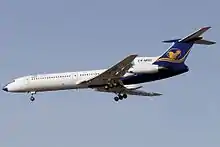Iran Air Tours Flight 956
Iran Air Tours Flight 956 was a Tupolev Tu-154M which crashed 230 miles (370 km) south-west of Tehran on 12 February 2002. During a non precision approach to runway 11, the airliner impacted the Kuh-e Sefid Mountain at an altitude 9,100 feet, three nautical miles left of the runway centerline. All 12 crew and 107 passengers were killed in the crash. The aircraft was carrying four government officials.[1][2]
 An Iran Air Tupolev Tu-154M similar to the aircraft involved in the incident. | |
| Accident | |
|---|---|
| Date | 12 February 2002 |
| Summary | Controlled flight into terrain |
| Site | Mount Sefid Kuh, Kermanshah, Iran |
| Aircraft | |
| Aircraft type | Tupolev Tu-154M |
| Operator | Iran Air Tours |
| Registration | EP-MBS |
| Flight origin | Tehran-Mehrabad Airport Tehran, Iran |
| Destination | Khorramabad Airport, Khorramabad, Iran |
| Occupants | 119 |
| Passengers | 107 |
| Crew | 12 |
| Fatalities | 119 |
| Survivors | 0 |
Aircraft
The involved aircraft was a Tupolev Tu-154M, with manufacturer number 91A-871 and serial number 08-71. Built by Aviakor, it made its first flight on May 21, 1991 and was delivered to the Ministry of Civil Aviation in June 1991, which assigned the aircraft registration number USSR-85698 and sent it to the Azerbaijan Department. In 1993 the airliner was re-registered to 4K-, the aircraft registration for Azerbaijan as a result of the collapse of the Soviet Union.
After the overhaul the aircraft was leased to pay for the work by ARZ-400, which in turn subleased it to the Bulgarian company Balkangtsev in May 2000, the registration was changed to LZ-LTO, and in December 2000, was subleased to another Bulgarian company, Bulgarian Air Charter (BAC), with the registration once again changed to LZ-LCO. On January 21, 2002, the airliner was subleased by BAC to Iran Air Tours, and the registration changed to EP-MBS. In total, by the day of the accident, the aircraft had accumulated 12,701 hours of flight time and 5516 cycles.[3] It was equipped with three turbojet engines D-30KU-154-II.[4]
Crash
Flight 956 of Iran Air Tours departed from Tehran to Horremabad at 7:30 a.m.[5] with 12 crew members and 107 passengers on board. Among the passengers were 4 government officials and at least 4 Spanish passengers. The landing was carried out in bad weather conditions, with the crew deviating from the left axis of the runway for 3 km. Approximately 15 miles from the airport, at an altitude of 9,100 feet (2,773 meters) above sea level (5,300 feet or 1,620 meters), the Tu-154 crashed into the Kuh-e Sefid mountain near the village of Sarab-e Dowreh and exploded. All 119 occupants on board were killed. Firstly, newspapers mistakenly indicated 117 dead.[4][1]
Aftermath
Shortly after the accident, some deputies called for the resignation or dismissal of Transport Minister, Ahmad Khorram, as well as the head of the civil aviation organization Behzad Mazheri. About 150 deputies wrote a letter to President Mohammad Khatami, asking him to take the necessary measures in the case of disclosure of the causes of the accident.[6]
There were also opinions that the main reason for the catastrophe was the American sanctions against Iran, due to which the Iranian airlines could not buy spare parts for Boeing aircraft purchased before the 1979 Iranian Revolution, but were forced to rent old airliners of the post-Soviet era.[1] Iran Air Tours announced that it was ceasing to operate Tupolev aircraft,[6] but this action was never implemented.
References
- "Iran plane crash kills 117". BBC News. 12 February 2002. Retrieved 15 January 2014.
- "Tupolev 154M EP-MBS Sarab-e Do Rah". Aviation Safety Network. Retrieved 15 January 2014.
- "Туполев Ту-154М Бортовой №: EP-MBS" (in Russian). Retrieved 26 November 2020.
- "ASN Aircraft accident Tupolev Tu-154M EP-MBS Sarab-e Do Rah". Retrieved 26 November 2020.
- "Iranian Passenger Plane Crashes". Retrieved 26 November 2020.
- "Iran completes recovery of all 119 bodies from plane crash". Retrieved 26 November 2020.